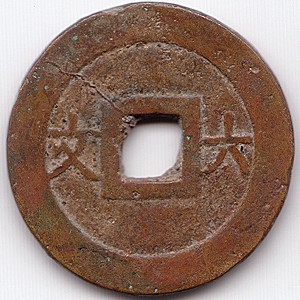Vietnamese văn (currency unit)
Văn was a historical currency unit used in Vietnam during various periods of its history. The term "văn" was primarily used to denote a unit of account rather than a specific coin or note. It played a significant role in the economic and monetary systems of Vietnam, particularly during the Lê dynasty and the Nguyễn dynasty.
History[edit | edit source]
The use of the văn as a currency unit can be traced back to the Lý dynasty (1009–1225), but it became more standardized during the Lê dynasty (1428–1789). During this period, the Vietnamese economy was heavily influenced by the Chinese monetary system, and the văn was often used in conjunction with other units such as the quan and the đồng.
Monetary System[edit | edit source]
The Vietnamese monetary system during the Lê and Nguyễn dynasties was complex, involving various units of currency. The văn was typically used as a smaller unit of account, with larger transactions being conducted in quan or đồng. The exchange rates between these units varied over time and were influenced by factors such as inflation, trade, and government policy.
Usage[edit | edit source]
The văn was used in various forms, including copper coins and paper money. Copper coins were the most common form of currency and were often inscribed with the reign title of the ruling emperor. Paper money, although less common, was also used and was typically issued by the central government.
Decline[edit | edit source]
The use of the văn declined in the late 19th and early 20th centuries as Vietnam came under increasing French colonial rule. The French introduced their own currency system, which gradually replaced the traditional Vietnamese units of account. By the early 20th century, the văn had largely disappeared from everyday use.
Legacy[edit | edit source]
Although the văn is no longer in use, it remains an important part of Vietnam's historical and cultural heritage. It is studied by historians and numismatists who are interested in the economic history of Vietnam and the broader region of Southeast Asia.
See also[edit | edit source]
References[edit | edit source]
External links[edit | edit source]
Search WikiMD
Ad.Tired of being Overweight? Try W8MD's physician weight loss program.
Semaglutide (Ozempic / Wegovy and Tirzepatide (Mounjaro / Zepbound) available.
Advertise on WikiMD
|
WikiMD's Wellness Encyclopedia |
| Let Food Be Thy Medicine Medicine Thy Food - Hippocrates |
Translate this page: - East Asian
中文,
日本,
한국어,
South Asian
हिन्दी,
தமிழ்,
తెలుగు,
Urdu,
ಕನ್ನಡ,
Southeast Asian
Indonesian,
Vietnamese,
Thai,
မြန်မာဘာသာ,
বাংলা
European
español,
Deutsch,
français,
Greek,
português do Brasil,
polski,
română,
русский,
Nederlands,
norsk,
svenska,
suomi,
Italian
Middle Eastern & African
عربى,
Turkish,
Persian,
Hebrew,
Afrikaans,
isiZulu,
Kiswahili,
Other
Bulgarian,
Hungarian,
Czech,
Swedish,
മലയാളം,
मराठी,
ਪੰਜਾਬੀ,
ગુજરાતી,
Portuguese,
Ukrainian
Medical Disclaimer: WikiMD is not a substitute for professional medical advice. The information on WikiMD is provided as an information resource only, may be incorrect, outdated or misleading, and is not to be used or relied on for any diagnostic or treatment purposes. Please consult your health care provider before making any healthcare decisions or for guidance about a specific medical condition. WikiMD expressly disclaims responsibility, and shall have no liability, for any damages, loss, injury, or liability whatsoever suffered as a result of your reliance on the information contained in this site. By visiting this site you agree to the foregoing terms and conditions, which may from time to time be changed or supplemented by WikiMD. If you do not agree to the foregoing terms and conditions, you should not enter or use this site. See full disclaimer.
Credits:Most images are courtesy of Wikimedia commons, and templates Wikipedia, licensed under CC BY SA or similar.
Contributors: Prab R. Tumpati, MD



